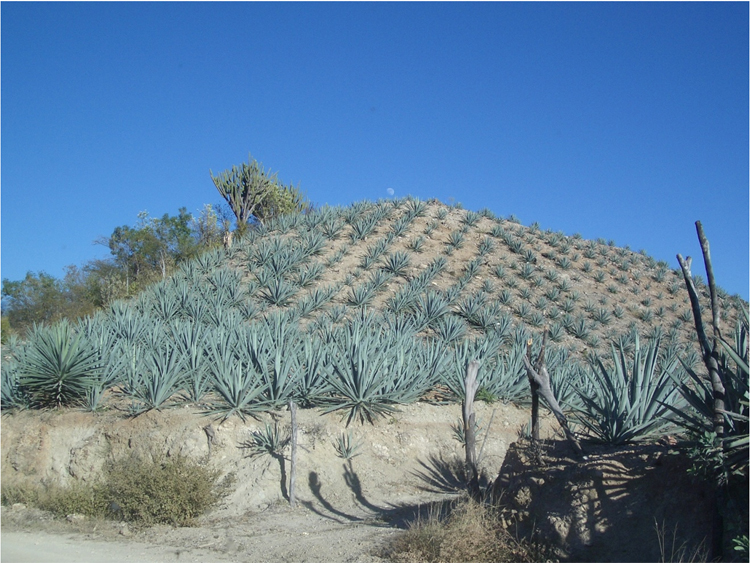Mezcal. I’d read about it, but never given it much thought. Even after Doug Frost opined about its smokey richness back in, oh, 2007 or so. Even after Saveur published a killer article about it in 2009. Even after Ryan Maybee stocked Manifesto’s bar with it, and Beau Williams earned second place with his mezcal-based La Prohibida at the 2009 Greater Kansas City Bartending Competition.
So, yes, I’m a bit late to the party. But boy am I glad to be here now.
In fairness, mezcal was hard to come by until recently, as few brands were imported into the U.S. from Mexico, and even fewer made their way to KC. It’s not as if it’s a new spirit, though. Indeed, mezcal is very, very old, predating tequila by a couple of centuries at least, according to Joanne Weir’s Tequila: A Guide to Types, Flights, Cocktails, and Bites.

Mezcal myth holds that when the Spanish invaded Mexico in the sixteenth century, they began running the local pulque (a fermented drink made from maguey, or agave, juice) through copper stills. The result, dubbed vino de mezcal or mezcal tequila, was the first distilled spirit produced in the Americas, according to Weir. Karl Petzke’sTequila: Myth, Magic & Spirited Recipes adds that José Antonio Montaño Cuervo registered the first mezcal distillery in the town of Tequila in 1758.
Ron Cooper, owner of Del Maguey Mezcal, holds that mezcal is even older than that. “Indigenous peoples were distilling way before (many hundreds of years) the Spanish brought copper alembic stills,” he told me via email. He would know. His mezcals are all made the traditional way, connecting us to those long-ago ancients and their mystical spirits.
As Cooper tells it, he discovered mezcal on a 1970 road trip through Mexico. He continued to visit over the years, getting to know mezcal makers, or palenqueros, in Oaxaca. He started Del Maguey in 1995 to ensure a steady U.S. supply of mezcal for himself and his buddies, but few others seemed to want it. Sales were slow, but Cooper didn’t really care. It was cheaper than flying down to bring in two bottles at a time (the legal limit when importing for personal use), he says.
“I wasn’t scheming a business deal,” Cooper said when we chatted by phone a few weeks ago. “I’m an artist, a sculpture and a painter.”
Cooper’s befriended countless palenqueros over the years, and this is how they do it: maguey or agave hearts (piñas) are put into a pit with hot stones, covered with earth and then roasted for three to five days. They’re then ground with horse-powered stone mills, fermented in wooden vats and then distilled twice in wood-fired clay or copper stills, according to his web site, which also has amazing photos of this rustic process, as does Del Maguey’s Facebook page. The result is a smokey, earthy and warm spirit—utterly unforgettable.
Cooper’s line of artisanal mezcals, most named for the village where they’re produced, gradually won fans. Distribution spread—a recent stop at Gomer’s on 39th Street showed Del Maguey’s Mezcal Vida ($36), Crema de Mezcal ($42), Single Villages Chichicapa ($69), Santo Domingo Albarradas ($69) and Tobala (forgot to check, but it’s probably $100+) on the shelves; they were out of the San Luis del Rio. Gomer’s also carries the Los Nahuales ($65) and Sombra ($44) brands.
As for what it all tastes like, well, I’m still working on that. I’ve only had it in cocktails so far, and it makes a far more earthy and seductive drink than, say, your everyday tequila. I get regular cravings for the Old Oaxacan at Manifesto, made with Del Maguey, agave nectar, Peychaud’s Bitters and a splash of water, stirred and served in a rocks glass with a massive chunk of ice. I hear Del Maguey’s also on the menu at JJ’s Restaurant on the Plaza.
Anyone wanting to get busy at home can turn to the Del Maguey site, which lists dozens of drinks recipes from bars across the country. Or try this one from Weir’s book (she attributes it to Philip Brady of New York’s Death & Co.).
Oaxaca Old-Fashioned: Combine 1/4 ounce agave nectar, 1/2 ounce mezcal, 1-1/2 ounce reposado tequila, 2 dashes Angostura bitters in a cocktail shaker with plenty of ice and stir for 15 seconds. Strain into a Collins glass filled with fresh ice; garnish with a flamed orange peel.

